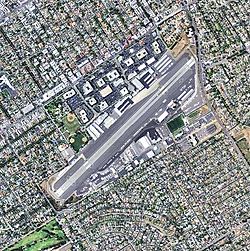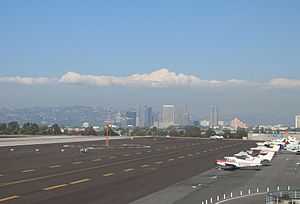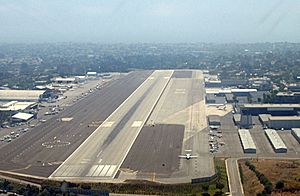Santa Monica Airport facts for kids
Quick facts for kids
Santa Monica Airport
Santa Monica Municipal Airport
Clover Field
|
|||||||||||
|---|---|---|---|---|---|---|---|---|---|---|---|

2006 USGS airphoto
|
|||||||||||
| Summary | |||||||||||
| Airport type | Public | ||||||||||
| Owner | Santa Monica | ||||||||||
| Operator | Santa Monica Airport Commission | ||||||||||
| Serves | Greater Los Angeles | ||||||||||
| Location | Santa Monica and Mar Vista, Los Angeles, California, U.S. | ||||||||||
| Opened | April 15, 1923 | ||||||||||
| Elevation AMSL | 54 m / 177 ft | ||||||||||
| Coordinates | 34°00′57″N 118°27′05″W / 34.01583°N 118.45139°W | ||||||||||
| Map | |||||||||||
| Runway | |||||||||||
|
|||||||||||
| [[Helipad|]] | |||||||||||
|
|||||||||||
|
Source: Federal Aviation Administration,
|
|||||||||||
The Santa Monica Airport (SMO, KSMO) is a public airport in Santa Monica, California. It is mainly used for general aviation, which means it handles private planes, business jets, and flight training. The airport is located in the Greater Los Angeles area.
It first opened on April 15, 1923, making it one of the oldest airports in the United States. For a long time, it was one of the busiest single-runway airports in the world. The airport covers about 215 acres (87 hectares) of land.
The airport is about 2 miles (3 km) from the Pacific Ocean. It is also about 6 miles (10 km) north of Los Angeles International Airport (LAX). The Federal Aviation Administration (FAA) calls it a "reliever airport". This means it helps reduce air traffic at bigger airports like LAX. The Santa Monica Airport is planned to close at the end of 2028.
One of the airport's old airplane hangars, called the Barker Hangar, is now a popular place for public events. Many TV awards shows and concerts have been held there.
Contents
Airport History
Early Days as Clover Field
The airport was first known as Clover Field. It was named after a World War I pilot, 2nd Lieutenant Greayer Clover. This airport was once the main home for the Douglas Aircraft company.
A very important event happened here in 1924. The first time anyone flew around the world was by the U.S. Army. Their special planes, called the Douglas World Cruiser, started their journey from Clover Field on March 17, 1924. They returned to the same spot after flying about 28,000 miles (45,000 km).
Famous early pilots like Amelia Earhart and Howard Hughes also used Clover Field. The first "Powder Puff Derby" race for women pilots also began here. Today, Cloverfield Boulevard in Santa Monica is named after the airport's original name.
World War II Efforts
During World War II, Clover Field was a very busy place. The Douglas Aircraft Company built many important planes here. They made the famous Douglas Commercial "DC" series of airliners, like the DC-3 and DC-4.
Thousands of military transport planes, such as the C-47 and C-54, were also built in Santa Monica. To protect the airport from enemy attacks during the war, Hollywood artists helped create a clever disguise. They built a fake "town" on top of the airport to hide it from the air.
After World War II
Becoming a General Aviation Airport
In 1958, Donald Douglas wanted to make the runway longer. This would allow Douglas Aircraft to build and test their new DC-8 jets. However, people living nearby were worried about noise. The city decided not to lengthen the runway.
Because of this, Douglas Aircraft moved its plane production to Long Beach Airport. This plant had employed 44,000 workers during World War II. After Douglas left, Santa Monica Airport became a "reliever airport" for general aviation. It mostly served business planes, training aircraft, and private planes.
Discussions About Airport Use
Starting in the late 1970s, there were many discussions about the airport's future. Some local residents wanted to limit or even close the airport. They were concerned about noise from the planes. The city government began to set rules, like limits on how loud planes could be.
These discussions continued for many years. The airport land is in a busy area, making it valuable for other types of development. In 2009, studies showed that the airport might be causing air pollution in nearby neighborhoods. This was especially true for tiny particles that could affect children and older people.
In 2017, the FAA and the city agreed on a plan. The city could shorten the runway from 4,925 feet (1,501 m) to 3,500 feet (1,067 m). This change made it harder for most large jets to use the airport. The agreement also said the airport would close completely by the end of 2028.
Modern Events at the Airport
In 2022, the Frieze Art Fair announced it would hold its Los Angeles event at the airport. It used a large temporary tent and hosted over 100 art exhibitors in 2023.
U.S. Presidents Donald Trump and Joe Biden have also landed at Santa Monica Airport. They arrived in their Marine One helicopter during visits to the area.
Airport Operations

The Santa Monica Airport has a control tower to guide aircraft. On average, it handled about 296 operations each day in 2011. By 2014, this number had decreased to about 83,381 operations per year.
Since the airport is surrounded by homes, the City of Santa Monica has strict rules about noise. These rules help reduce the sound of planes for people living nearby. The airport staff works to make sure planes have less impact on residential areas.
Here are some of the rules:
- Maximum Noise Level: Planes cannot make more than 95.0 dBA of noise. This rule is in effect all day, every day.
- Night Departure Curfew: Planes cannot take off or start their engines between 11 PM and 7 AM on weekdays. On weekends, this curfew lasts until 8 AM. Exceptions are only for medical or public safety emergencies.
- Operational Limitations: Certain flight practices, like "touch-and-go" landings, are not allowed on weekends, holidays, or late at night.
The Federal Aviation Administration (FAA) sets rules for how planes operate and use the airspace. The city cannot make new laws that would change these federal aviation rules.
The Cloverfield restaurant is located near the airport. The Museum of Flying is also at the airport. It has a collection of old and historic aircraft. One of the airport's oldest buildings is home to the U.S. Civil Air Patrol's Clover Field Composite Squadron 51.
Landing Fees
Since August 1, 2005, planes landing at Santa Monica Airport have to pay a fee. This fee is based on how much the plane weighs. The airport does not get money from federal, state, or local governments to operate. These landing fees help cover the costs of running the airport.
Airport Park
An 8.3-acre (3.4-hectare) public park, called Airport Park, opened on land that used to be part of the airport. It has a soccer field, open green spaces, and an area where dogs can play off-leash.
Barker Hangar Events
The Barker Hangar is an old airplane hangar that has been turned into a large event space. It is about 35,000 square feet (3,250 square meters). It was built in 1954 by Bill Lear, who invented the Learjet.
Today, the hangar hosts many different events. These include art shows, concerts, food festivals, and trade shows. The band INXS recorded a live album there in 1993. Award shows like the MTV Movie & TV Awards and the People's Choice Awards have also been held at the Barker Hangar.
The Airport's Future
The city has asked the public for ideas about what to do with the airport land in the future. In November 2014, voters approved Measure LC. This measure limits how the land can be used once the airport closes. It says the land must be used for "public parks, recreational facilities or open space."
On January 28, 2017, city officials and the FAA announced an agreement. The Santa Monica Airport will close on December 31, 2028. After that, the 227 acres of airport land will be returned to the city. The plan is to turn this land into areas for parks, open spaces, recreation, education, or cultural uses.
To reduce jet traffic before the full closure, the city shortened the runway. On December 23, 2017, the runway was changed from 4,973 feet (1,516 m) to 3,500 feet (1,067 m). This was done by repainting the runway and moving some navigation equipment.
Safety Incidents
Over the years, there have been some safety incidents at or near the airport. These events are carefully investigated to learn how to prevent future problems.
- In 1989, a P-51 Mustang plane had engine trouble after takeoff. The pilot tried to return to the airport but crashed into a house. The pilot and passenger were injured.
- In 1993, a small plane crashed into an apartment building after takeoff. Three people on board were sadly lost.
- In 2001, a pilot and passenger were lost when their plane overran the runway. This happened after an attempt to stop the takeoff was unsuccessful.
- In 2006, game-show host Peter Tomarken and his wife were lost when their plane crashed. It had engine trouble after takeoff and fell into Santa Monica Bay.
- In 2009, a small plane lost power after takeoff and crashed. Two people were lost in this incident. Investigators found the pilot had not selected the correct fuel tank.
- In 2013, a business jet veered off the runway after landing and crashed into a hangar. The pilot and his son were sadly lost.
- In 2015, actor Harrison Ford had engine trouble in his vintage plane after takeoff. He made an emergency landing on a nearby golf course. He was injured but recovered.
- In 2022, a small Sport Cruiser plane stalled and crashed on landing. Both people on board were sadly lost.



